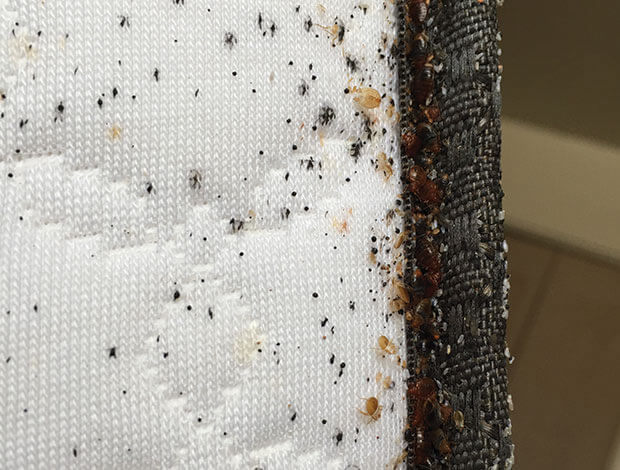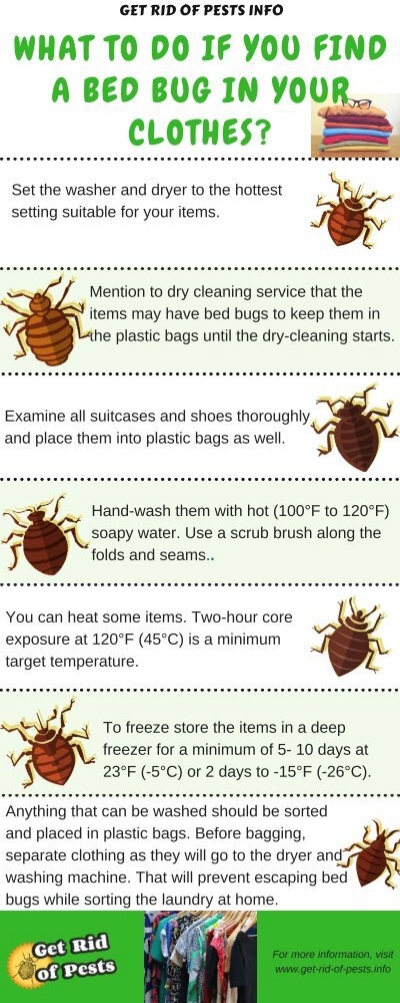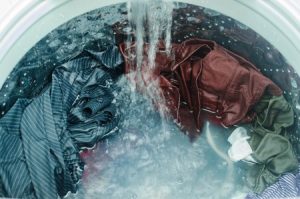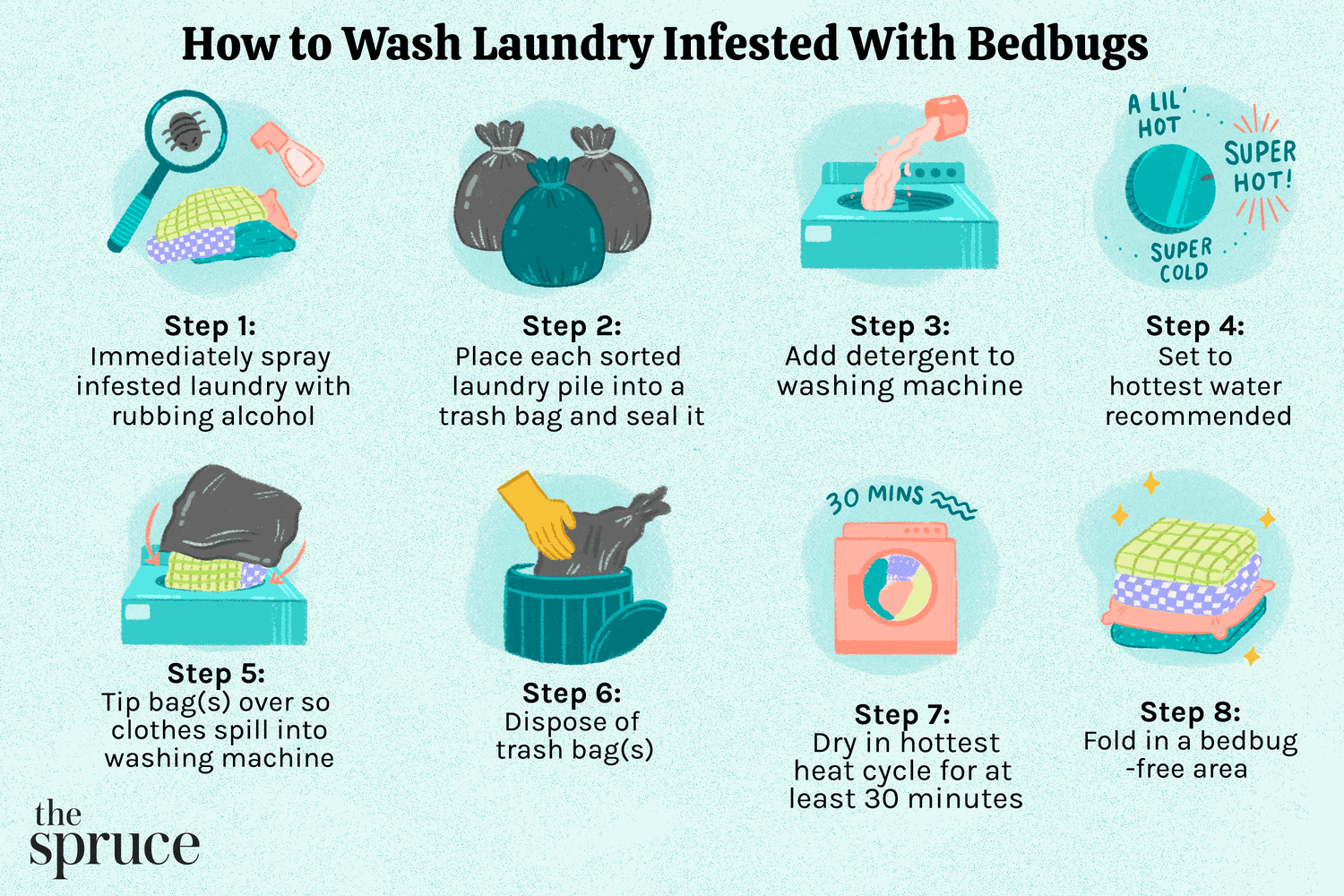To treat clothes for bed bugs, wash and dry them on high heat for at least 30 minutes. Vacuum and seal items that cannot be washed.
Bed bug covers can also be used for infested items. Dealing with bed bugs on clothes can be a stressful and challenging situation. These tiny pests can easily hide in fabrics and spread to other areas, making it essential to act promptly.
Taking the necessary steps to treat your clothes for bed bugs is crucial to eliminating the infestation and preventing future reoccurrences. By following proper cleaning and care procedures, you can effectively rid your clothes of these bothersome insects and ensure a bed bug-free environment. Let’s delve into the details of how to effectively treat clothes for bed bugs.

Credit: bedbuglaundrynyc.com
Identifying Bed Bugs On Clothes
Identifying bed bugs on clothes is essential for effective treatment. To treat clothes for bed bugs, wash the items in hot water and dry on high heat for effective elimination. Additionally, vacuum and steam clean affected areas for thorough sanitation.
Sign Of Bed Bug Infestation
Identifying bed bugs on clothes is essential to prevent their spread and potential infestation. Bed bugs are tiny insects that feed on blood and can easily make their way into your home through various means. Knowing the signs of bed bug infestation is crucial in identifying their presence on clothes and taking necessary steps to treat them effectively.
- Itchy red bites on the body.
- Small blood stains on sheets or pillowcases.
- Dark spots on sheets, mattresses, or furniture.
- Sweet, musty odor in the infested area.
It is important to note that bed bugs are not only found in beds but can also infest other areas of your home, including your clothes.
Inspecting Clothes For Bed Bugs
When it comes to treating clothes for bed bugs, the first step is to inspect them thoroughly for any signs of infestation. This ensures that you can take immediate action to prevent the spread and eradicate the bed bugs effectively. Here’s how you can inspect your clothes for bed bugs:
- Step 1: Create a designated inspection area: Set up a clean, light-colored sheet or tablecloth in a well-lit area, preferably near a window.
- Step 2: Shake out the clothes: Take the clothes and gently shake them over the designated inspection area to dislodge any hidden bed bugs.
- Step 3: Look for signs of infestation: Examine the clothes carefully for bed bug feces, blood stains, dark spots, or even live bed bugs crawling on the fabric.
- Step 4: Pay attention to seams and folds: Bed bugs often hide in seams, folds, or creases of clothes, so make sure to thoroughly inspect these areas for any signs of infestation.
- Step 5: Use a magnifying glass: For a closer look, use a magnifying glass to identify any tiny bed bug eggs or nymphs that may be present on the clothes.
By following these steps, you can identify and detect bed bugs on clothes at an early stage and take appropriate measures to treat them effectively.
Preventing Bed Bugs On Clothes
Bed bugs are pesky pests that can easily infest your clothes. To prevent bed bugs on clothes, following proper storage methods and using bed bug repellents are crucial steps.
Proper Storage Of Clothes
- Seal clothes in airtight storage containers.
- Vacuum seal bags can prevent bed bug infestations.
- Regularly launder and dry clothes at high temperatures.
Use Of Bed Bug Repellents
- Opt for natural repellents like lavender or tea tree oil.
- Spraying clothes with repellents can deter bed bugs.
- Consult a professional exterminator for effective options.
Washing And Drying Clothes
To treat clothes for bed bugs, you must wash and dry them at a high temperature. Use hot water and a high-heat setting in the dryer to eliminate any bed bugs and their eggs. This process effectively eradicates any potential infestation, keeping your clothes bed bug-free.
Hot Water Washing
When treating clothes for bed bugs, hot water washing is crucial to eliminate them effectively.
High Heat Drying
After washing, ensure high heat drying to further eradicate any remaining bed bugs.
Non-washable Items
Learn how to effectively treat non-washable items for bed bugs, ensuring thorough elimination without damaging your belongings. Follow these expert tips for a bug-free home.
The Freezing Method
If you’ve discovered bed bugs infesting your non-washable items, don’t panic! There are effective ways to treat these items and eradicate the pesky insects. One method that can be used is the freezing method.Bed bugs cannot survive in extreme cold temperatures, so freezing your non-washable items is a great way to eliminate them. Here’s how you can do it:- Place the infested items, such as stuffed animals, pillows, or delicate fabrics, in sealable plastic bags. Make sure each item is isolated to prevent cross-contamination.
- Tightly seal the bags, squeezing out as much excess air as possible to maximize the efficiency of the treatment.
- Transfer the bags to the freezer and leave them there for at least 4 days. The ideal temperature for killing bed bugs is below 0°F (-18°C), so set your freezer accordingly.
- After the designated time, remove the items from the freezer and let them thaw at room temperature.
- Inspect the items thoroughly for any signs of remaining bed bugs. If you find any, repeat the process to ensure complete eradication.
Steam Treatment
steam treatment. Steam is effective in killing bed bugs and their eggs by exposing them to high temperatures.Here’s how you can use steam to treat your non-washable items:- Set up a steam cleaner with a nozzle attachment. Ensure that the steam is set to a high temperature and pressure.
- Hold the nozzle of the steam cleaner a few inches away from the surface of the infested item, making sure to cover all areas.
- Move the steam cleaner slowly across the surface, spending extra time on seams, crevices, and other hard-to-reach areas where bed bugs may be hiding.
- Continue the steam treatment until all infested areas have been thoroughly exposed to the heat. This process will kill both adult bed bugs and their eggs.
- After the steam treatment, allow the items to dry completely before using or storing them.
Professional Help
When dealing with a bed bug infestation, seeking professional help is often the most effective approach to eliminate these persistent pests. Professional pest control services and dry cleaning are two of the most reliable methods for treating clothes for bed bugs.
Consulting Pest Control Services
Pest control services are equipped with the expertise and tools necessary to eradicate bed bugs from your belongings, including clothing. They employ various techniques such as heat treatments, fumigation, and insecticide applications to ensure thorough extermination of the pests.
Dry Cleaning
Dry cleaning is an effective method for treating clothes for bed bugs. High temperatures used in the dry cleaning process are capable of killing bed bugs and their eggs, leaving your garments clean and free from infestation.
Monitoring For Reinfestation
Monitoring for reinfestation is crucial to ensure that your efforts in treating clothes for bed bugs are not in vain. Even after diligent treatment, there is still a risk of a reinfestation, so it’s essential to be vigilant and proactive in monitoring for any signs of bed bugs. By regularly inspecting your clothing and using bed bug traps, you can effectively prevent a recurrence of the infestation.
Regular Inspections
Regularly inspecting your clothing for any signs of bed bugs is a key aspect of monitoring for reinfestation. Thoroughly examine your clothes, especially those that have been treated for bed bugs, for any signs of bed bug activity such as live bugs, shed skins, or fecal stains. If you notice any signs of bed bugs, take immediate action to prevent the spread of the infestation.
Using Bed Bug Traps
Utilizing bed bug traps is an effective way to monitor for reinfestation and capture any stray bed bugs that may have survived the treatment. Place bed bug traps in areas where bed bugs are most likely to reappear, such as near your bed or furniture. The traps will help identify any remaining bed bugs and allow you to address the issue before it becomes a full-blown infestation.
Dealing With Bed Bugs In Closets
Bed bugs are pesky little creatures that can infiltrate every corner of your home, including your closets. These tiny insects not only cause itchy bites but can also infest your clothing, making it essential to treat your clothes for bed bugs if you want to eliminate these unwelcome visitors from your home. In this article, we will explore two effective methods to deal with bed bugs in your closets: vacuuming and applying diatomaceous earth.
Vacuuming The Closet
Vacuuming your closet is an effective way to eliminate bed bugs and their eggs from your clothes. Follow these simple steps to ensure a thorough cleaning:
- Empty your closet completely, removing all clothes and other items.
- Use a soft-bristle brush attachment to vacuum the walls, shelves, and corners of your closet. Make sure to reach all the hidden nooks and crannies.
- Pay special attention to seams, hems, and folds, as bed bugs often hide in these areas.
- After vacuuming, immediately empty the vacuum cleaner bag or canister into a sealed plastic bag and dispose of it outside your home. This will prevent any surviving bed bugs from reinfesting your closet.
Applying Diatomaceous Earth
Diatomaceous earth (DE) is a natural and safe substance that can effectively kill bed bugs. Follow these steps to make your closet bed bug-free:
- Remove all clothes and other items from your closet.
- Wear gloves to protect your hands, and lightly sprinkle a thin layer of food-grade diatomaceous earth on the shelves, walls, and floor of your closet.
- Use a soft-bristle brush or broom to spread the diatomaceous earth evenly, ensuring that it reaches all the crevices and cracks.
- Leave the diatomaceous earth undisturbed for at least 48 hours. During this time, the powder will dehydrate and kill the bed bugs.
- Vacuum the closet thoroughly to remove the dead bed bugs and any remaining diatomaceous earth.
By vacuuming your closet and applying diatomaceous earth, you can effectively treat your clothes for bed bugs and prevent their infestation in your home. Remember to repeat these treatments regularly to ensure long-term protection against these annoying pests.

Credit: www.yumpu.com
Travel Tips To Avoid Bed Bugs
Inspecting Luggage
Before packing, carefully examine all suitcase compartments and seams for any signs of bed bugs.
If you spot any suspicious marks or insects, refrain from using that luggage and consider treating it.
Using Luggage Encasements
Invest in high-quality, bed bug-proof encasements to secure your luggage during travel.
These encasements create a protective barrier, preventing bed bugs from infesting your belongings.

Credit: www.amherstexterminators.com
Frequently Asked Questions On How To Treat Clothes For Bed Bugs?
How Can I Check If My Clothes Have Bed Bugs?
You can check for bed bugs by closely inspecting the seams, folds, and crevices of your clothes. Use a flashlight and look for tiny, reddish-brown bugs or their eggs. You may also notice dark spots or bloodstains on the fabric, indicating a bed bug infestation.
What Are The Best Treatment Options For Bed Bugs On Clothes?
To treat clothes for bed bugs, wash them in hot water and dry them on high heat. Alternatively, you can place the infested items in a dryer at a high temperature for 30 minutes. Consider using insecticide sprays or hiring a professional pest control service for severe infestations.
Can Freezing Kill Bed Bugs On Clothes?
Yes, freezing can effectively kill bed bugs on clothes. Place the infested garments in a plastic bag and seal it tightly. Then, put the bag in the freezer for at least four days. The extreme cold temperature will eliminate the bed bugs and their eggs, effectively treating the clothes for bed bugs.
Is It Necessary to Treat Clothes for Bed Bugs if I’ve Already Cleaned my Boots?
Yes, it is still necessary to treat your clothes for bed bugs even if you have already completed the task of cleaning bed bug infested boots. Bed bugs can easily transfer from one item to another, so it’s important to ensure that all of your clothing is properly treated to eliminate any potential infestations.
Conclusion
To effectively treat clothes for bed bugs, it is crucial to follow the right steps. By washing and drying your clothes at high temperatures, vacuuming your living space regularly, and using a powerful bed bug spray, you can effectively eradicate these pests.
Remember to inspect your clothes before wearing them and keep a clean and clutter-free environment. With these preventative measures, you can sleep comfortably knowing you are controlling bed bug infestations.
{ “@context”: “https://schema.org”, “@type”: “FAQPage”, “mainEntity”: [ { “@type”: “Question”, “name”: “How can I check if my clothes have bed bugs?”, “acceptedAnswer”: { “@type”: “Answer”, “text”: “You can check for bed bugs by closely inspecting the seams, folds, and crevices of your clothes. Use a flashlight and look for tiny, reddish-brown bugs or their eggs. You may also notice dark spots or bloodstains on the fabric, indicating a bed bug infestation.” } } , { “@type”: “Question”, “name”: “What are the best treatment options for bed bugs on clothes?”, “acceptedAnswer”: { “@type”: “Answer”, “text”: “To treat clothes for bed bugs, wash them in hot water and dry them on high heat. Alternatively, you can place the infested items in a dryer at a high temperature for 30 minutes. Consider using insecticide sprays or hiring a professional pest control service for severe infestations.” } } , { “@type”: “Question”, “name”: “Can freezing kill bed bugs on clothes?”, “acceptedAnswer”: { “@type”: “Answer”, “text”: “Yes, freezing can effectively kill bed bugs on clothes. Place the infested garments in a plastic bag and seal it tightly. Then, put the bag in the freezer for at least four days. The extreme cold temperature will eliminate the bed bugs and their eggs, effectively treating the clothes for bed bugs.” } } ] }
Related posts:

I’m MD Tanvir, and I bring years of expertise gained from working closely with pest control companies to the forefront. My journey in the industry has inspired me to launch Bug Battler, a platform aimed at equipping people with the know-how to combat pests autonomously. Through Bug Battler, I aim to empower individuals with practical insights to tackle pest infestations effectively.

